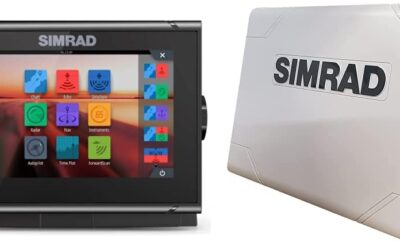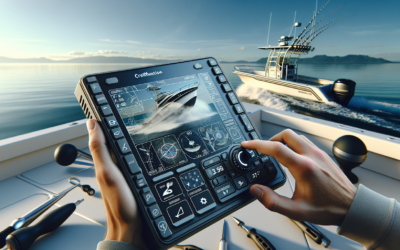Navigating the extensive tech-world of fish finders can be a daunting task, especially when it comes to choosing between touchscreen and button controls. As technology progresses, the once simplistic task of using a fish finder has transformed into a considerably more complex process. The purpose of this article is to help you cut through the confusion and discover for yourself- touchscreen or button controls, which is the best choice for your fishing needs? The following discussion will provide a comprehensive comparison of these two control options, evaluating their pros and cons, ease of use, reliability, and overall performance.
Understanding Basic Fish Finder Interfaces
Fish finders are an essential tool for any serious angler. They drastically improve your fishing experience by using sonar technology to help locate and track schools of fish underneath the water.
The Function of Fish Finders
Fish finders work by sending out sound waves into the water from a transducer. When these waves hit an object (such as a fish), they bounce back to the fish finder. The speed and intensity of the returned signal are used to approximate the size, shape, and location of the object.
Basic Interface Components
A basic fish finder interface generally includes a display screen where you can visualize the underwater terrain and locate fish schools, a power button, menu options to adjust settings, and controls to zoom in or out. The control can either be touchscreen or button-operated, depending on the model.
Latest Advancements in Fish Finder Technology
With advancements in technology, modern fish finders come with nifty features like GPS navigation, more precise imaging techniques like CHIRP sonar, and Wi-Fi connectivity for seamless information exchange. The most notable shift has been the introduction of touchscreen interfaces, a feature primarily limited to high-end models until now.
Touchscreen Fish Finders: A Detailed Analysis
Just like your smartphone, touchscreen fish finders rely on your touch input to carry out operations and navigate through different settings.
Defining Touchscreen Interface
Touchscreen interfaces are intuitive and engaging. They allow users to interact directly with the display by touching the screen where they wish to input information or make a selection.
Advantages of Touchscreen Fish Finders
Touchscreens offer many advantages. They provide a modern, sleek design, intuitive operation, and often come with a larger display. They tend to be more user-friendly, enabling easy data input, and quick navigation through menus.
Disadvantages of Touchscreen Fish Finders
However, touchscreen interfaces may be difficult to navigate with wet or gloved hands. In bright sunlight, the glare on the screen can make it difficult to see, and they are generally more expensive than button-controlled models.
Top Brands and Models of Touchscreen Fish Finders
Some of the top brands offering touchscreen fish finders include Garmin, Humminbird, and Lowrance. They offer a range of models catering to different budgets and needs, with high-end models offering advanced features like 3D visualization and dual-frequency operation.
Button Control Fish Finders: A Detailed Analysis
Many anglers still prefer old-school button control fish finders. They offer a robust and economical alternative to fancy touchscreen models.
Defining Button Control Interface
With a button control interface, you interact with the fish finder using physical buttons or keys usually located adjacent to the display screen.
Advantages of Button Control Fish Finders
Button control interfaces are generally more rugged. They work well even with wet or gloved hands and are typically cheaper than their touchscreen counterparts, making them a budget-friendly option.
Disadvantages of Button Control Fish Finders
On the downside, button controls can be slower to operate, the interface may not be as intuitive to first-time users, and you’ll typically have to deal with a smaller screen size.
Top Brands and Models of Button Control Fish Finders
Brands like Garmin, Lowrance, and Humminbird all offer reliable button control fish finders in their product lineup, with models varying in terms of sonar capabilities, screen resolution, and additional features like GPS.
Fish Finder Interface Features: A Comparative Study
We cannot compare touchscreen and button control fish finders without looking at the key features that determine their performance.
Screen Resolution and Quality
Screen quality matters a lot when you’re trying to interpret sonar readings. Touchscreen models often win this round with their high-resolution colored displays, while button controls often have to settle for smaller black and white or low-resolution color screens.
Ease of Use and Navigation
When it comes to navigating through different settings and options, touchscreens offer an edge with their intuitive interfaces. Button control interfaces, on the other hand, may take a while for you to get the hang of but they can still do the job effectively.
Adjustability and Personalization
Touchscreens again shine when it comes to adjustability, allowing you to zoom in and out freely by pinching or pulling on the screen with your fingers. Button control fish finders, however, may be limited in this aspect.
Durability and Longevity
Button control fish finders typically trump touchscreen models when it comes to durability and longevity. They are designed to withstand rough handling and harsh outdoor conditions.
Ease of Use: Touchscreen Vs. Button Control
A fish finder’s ease of use often depends on user preference and familiarity with touchscreen or button control interfaces.
Initial Learning Curve
Touchscreen fish finders typically offer a gentler learning curve for most users, especially those accustomed to smartphones. However, the button control interface can also be easy to learn, despite the slightly old-fashioned approach.
Mastery and Proficiency
Once you’ve learned the basics, both systems can be operated efficiently. However, touchscreens may offer a quicker path to proficiency due to their intuitive design.
Suitability for Beginners Vs. Experienced Users
Both button control and touchscreen fish finders can serve both beginners and experienced anglers. For tech-savvy individuals or those prefer sleek and modern designs, touchscreen would be more suitable. For those who prefer hard-wearing practicality and simplicity, a button control fish finder would be more suitable.
Durability and Maintenance: Touchscreen Vs. Button Control
When it comes to durability and maintenance, button control fish finders arguably take the lead.
Common Issues and Failures
Touchscreen fish finders can be sensitive to rough handling and are more prone to screen failures. Button control interfaces, while not immune to failure, typically handle harsh conditions better.
Repair and Maintenance Costs
If your fish finder malfunctions, touchscreen models can cost significantly more to repair. Button control models, while not inexpensive to repair, typically cost less than touchscreen counterparts.
Longevity and Lifespan
While the longevity of a fish finder to a great extent depends on how you handle and care for it, button control models are often considered more durable due to their simple construction and fewer delicate components.
Weather Conditions and Fish Finder Interfaces
Weather plays a crucial role in the performance of fish finder interfaces.
Touchscreen Performance in Various Weather Conditions
Touchscreen interfaces can become difficult to operate with cold, wet fingers. Bright sunlight can also create a glaring reflection on the screen, making it challenging to read.
Button Control Performance in Various Weather Conditions
Button control interfaces tend to handle weather extremes better. They are operable even with heavy gloves on and the screen remains readable in bright sunlight.
Price Comparison: Touchscreen Vs. Button Control
Looking at the price tags, there’s a visible difference between the two types of fish finders.
Average Cost of Touchscreen Fish Finders
Touchscreen fish finders, with their advanced technology and superior features, usually come with a hefty price tag. Can go well over a few hundred dollars depending on the brand and model.
Average Cost of Button Control Fish Finders
Button control fish finders can cost significantly less, making them a popular choice among budget-conscious buyers.
Value for Money: Comparing Features and Prices
When it comes to value for money, it depends on individual preference and needs. If you prioritize advanced technology and high resolution, touchscreen fish finders can be worth the investment. If you value practicality, durability and affordability, button control models offer excellent value.
User reviews and Feedback: Touchscreen Vs. Button Control
Lastly, customer reviews and feedback can give you valuable insights into real-world performance.
Customer Satisfaction and Reviews
Customer reviews on both touchscreen and button control fish finders are generally positive, with each style having its passionate group of supporters.
Professional Reviews and Recommendations
Professional critics also appreciate both types of interfaces, often emphasizing that the choice between touchscreen and button control largely comes down to personal preference, fishing environment, and the size of your budget.
Final Verdict: Touchscreen or Button Control – Which is Best?
Finally, when discussing which is best — touchscreen or button control fish finders, there isn’t a one-size-fits-all answer.
Weighing the Pros and Cons
The decision should be based on weighing the pros and cons that we discussed and determining which features matter most to you.
Choosing Based on Personal Needs and Preferences
The best fish finder for you will be one that fits your budget, is easy for you to use and offers the features that you need for your fishing adventures.
Industry Trends and Future Predictions
Yet, looking at the industry trends and future predictions, we cannot deny the growing popularity of touchscreen models, and we can surely expect to see more advanced and affordable touchscreen fish finders in the future.
With the information provided above, you should be armed with the knowledge to make an informed decision and equip yourself with the best fish finder for your fishing expeditions. Yes, the choice might seem daunting, but remember, the best fish finder is the one that helps you catch fish, whether that’s touchscreen or button control. Happy fishing!









